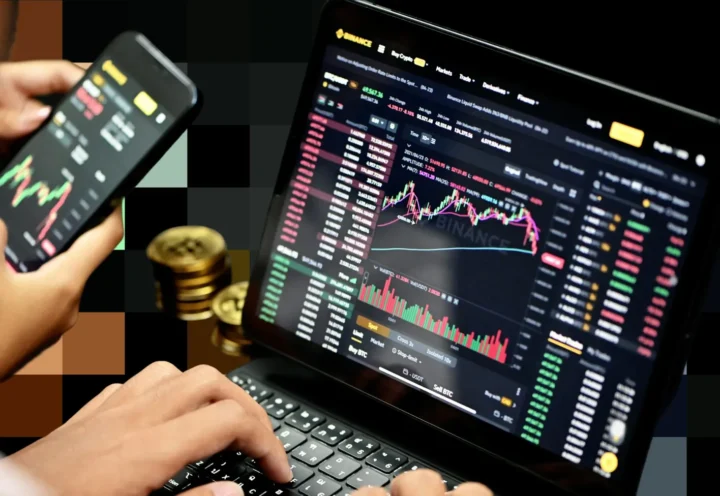When Binance’s Oracle Failed: Trading Economics, Risk Management, and the $19B Auto-Deleveraging Shock

Crypto moves faster than any traditional safety net can react. On October 10, 2025, the world’s largest exchange online, Binance, gave the industry a brutal reminder of how fragile modern trading economics can be. Within hours, more than US $19 billion in leveraged positions were wiped out after a surprise U.S. tariff announcement rocked global markets.
Bitcoin plunged below US $107,000, U.S. equities slumped, and several “pegged” assets on Binance — USDe, wBETH, and BNSOL — broke violently from their fundamentals.
- USDe is a synthetic U.S. dollar stablecoin issued by Ethena Labs, backed by delta-neutral hedging strategies rather than fiat reserves.
- wBETH (Wrapped Beacon ETH) represents staked Ethereum from Binance’s ETH 2.0 staking program.
- BNSOL (Binance-Staked Solana) is a wrapped token tied to SOL locked in Binance’s staking infrastructure.
All three should have traded near par with their underlying value. Instead, as Binance’s price-oracle malfunctioned, USDe collapsed to ~$0.65, while wBETH and BNSOL both plunged more than 80%. The chain reaction overwhelmed the exchange’s risk management framework and triggered Auto-Deleveraging (ADL) — the crypto-era equivalent of a clearinghouse default auction.
What ADL Actually Is
Auto-Deleveraging is the final line of defense in cryptocurrency derivatives risk management — the emergency brake in a high-speed trading economics system. When forced liquidations and insurance funds can’t cover losses, the exchange online automatically reduces profitable, highly leveraged positions on the opposite side of the trade.
In simpler terms: when the system runs out of collateral to pay winners, it trims a slice of their open profits to keep the venue solvent. It’s the digital descendant of the “mutualized-loss waterfall” used in traditional clearinghouses. Harsh? Yes. Necessary? Absolutely.
A Quick Analogy
ADL is like an overbooked flight. When no one volunteers to give up their seat, the airline must bump passengers to make the flight leave on time. In crypto, when no liquidity remains and the insurance fund is drained, the exchange online “bumps” profitable traders — trimming their exposure so the system can keep flying.
How the Mechanism Works
- Liquidation failure. A losing account hits its bankruptcy price — the point where losses exceed margin, and the order book can’t absorb the trade.
- Insurance fund depletion. The pool built from liquidation surpluses is empty.
- Systemic shortfall. The risk engine scans for profitable, leveraged traders on the opposite side and automatically closes part of their positions at the bankruptcy price.
Each trader’s position carries an ADL ranking, determined by unrealized profit and leverage:
(Ranking Score] = (Profit & Loss %) × [(Effective Leverage]
The higher your profit and leverage, the higher you sit in the ADL queue. When the system fires, the biggest winners with the biggest risk get hit first.
TradFi Comparisons
Traditional Finance Mechanism | Crypto ADL Equivalent | Purpose |
Clearinghouse default waterfall | Insurance fund to ADL queue | Absorb member defaults |
Default auction | Forced position offset | Transfer risk instantly |
Loss mutualization | Pro-rata ADL cuts | Preserve solvency |
Circuit breaker | Automatic leverage truncation | Prevent cascade failures |
Both systems exist for one reason: to save the market before it devours itself.
Binance’s 10/10/2025 Oracle Disaster
What began as a routine oracle update became the largest single-day deleveraging in crypto history. The Binance oracle, which weighted internal exchange prices too heavily, created a feedback loop: every tick down on Binance dragged the mark price lower across perpetual and futures contracts. That self-reference wiped out collateral values, tripped margin calls, and ignited a cascade of forced sales.
As liquidity evaporated, the insurance fund drained within minutes. With no backstop left, Binance’s risk management framework flipped the ADL switch — a move seldom seen since the 2020 ‘Black Thursday’ flash-crash and kept the exchange solvent. It was ugly but effective.
Zooming into the timeline:
- 04:40 UTC Oct 9: An account on Hyperliquid quietly funds $80 million USDC, gradually building a $400 million BTC short position.
- 20:50 UTC Oct 10: President Trump posts on Truth Social, threatening 100 % tariffs on China. Within minutes, crypto and equity futures plunge.
- 21:20 UTC: USDe slips below $1 on Binance; BTC and ETH hit intraday lows.
- 21:42-21:51 UTC: USDe collapses to $0.65; wBETH and BNSOL lose 80 % in minutes; ADL triggers on multiple venues.
- 23:59 UTC: Selling pressure ebbs; USDe re-pegs through redemptions; wBETH and BNSOL recover overnight.
- Oct 11 onward: Markets normalize; Binance announces compensation and a $100 million loan program for market makers.
The sequence resembled the 2010 U.S. ‘flash crash’ in equities: algorithms interacting, liquidity vanishing, and prices snapping back once order flow stabilized.
Why It Happened
Three forces collided:
- High leverage and thin books. Leverage across Binance Perpetuals was at record highs; order depth was shallow.
- Macro shock. A single headline shifted global trading economics, spiking volatility and shrinking liquidity.
- Oracle design flaw. The mark price depended on its own venue’s spot data. When the spot collapsed, the oracle spiraled down with it.
Together, they formed a self-reinforcing liquidation loop. ADL was the last resort that prevented the loop from destroying the platform.
Lessons for Professional Traders
For anyone trading on exchange online platforms such as Binance, understanding what risk management is essential, not theoretical. Build a risk management plan that accounts for leverage, liquidity, and asset dependencies.
- Mind the leverage. Stay below 5× effective leverage to keep your ADL ranking low.
- Realise profits in batches. Book gains before they inflate your risk score.
- Check collateral quality. Wrapped assets with Oracle dependencies carry hidden systemic risk.
- Diversify across accounts. Segment strategies so one account isn’t the entire ADL target.
- Follow disclosures. Monitor insurance-fund balances and ADL lights — they exist to warn you.
Professional traders treat ADL like weather: you can’t control it, but you can see the storm coming and plan around it.
Systemic Takeaway — Beyond Trader Behaviour
The 10/10 event proved that crypto risk is no longer just about reckless positions; it’s about market architecture. A buggy oracle can inflict as much damage as a bad derivatives book.
In trading economics, resilience depends on how robust the risk management framework truly is. ADL was never designed to be routine; it’s the emergency brake. If it fires, every other layer of defense – margin calls, insurance funds, liquidity buffers – has already failed.
For Binance and other online exchange operators, the lesson is simple: risk systems must be as sophisticated as trading interfaces. Multi-source oracles, redundant liquidity feeds, and transparent ADL metrics should be core infrastructure, not afterthoughts.
How Binance Rectified Losses After the 10/10/2025 Crash
In the aftermath, Binance moved quickly to stabilize markets and restore confidence — a masterclass in risk management planning.
1. Immediate Compensation Program (~ US $300 million)
Within 48 hours, Binance announced a compensation pool for users whose positions were liquidated as wrapped assets diverged from fair value. Reimbursements reflected the gap between crash-time prices and fundamental references, credited directly to user balances over the next week.
2. Market-Maker Support Facility (US $100 million)
To rebuild liquidity, Binance launched a low-cost loan program for professional market makers, providing short-term funding at reduced rates to deepen order books that had frozen during the crash.
3. Oracle and Margin System Audit
The exchange suspended its planned oracle upgrade, commissioned an external audit, and shifted temporarily to multi-source reference oracles to eliminate self-referential loops. Margin calculations for wrapped assets were also revised to use redemption or fundamental values instead of volatile spot marks.
4. Transparency and Communication
Binance published a detailed post-mortem on Binance Square explaining the cascade, ADL activation, and corrective measures. The company clarified that compensation was voluntary — a confidence-restoration gesture, not an admission of fault.
5. Future Safeguards
The company is committed to real-time risk dashboards, clearer ADL indicators, and a cross-margin risk management framework designed to isolate wrapped-asset exposures in future stress events.
In all, Binance absorbed roughly US $400 million in remediation, rewired its oracle logic, and strengthened its market infrastructure. The rapid recovery of pegged assets and resumption of normal trading within 24 hours suggested the measures worked — at least this time.
Why the Crash Was Big But Not Fatal
At $19 billion, the liquidations were historic — yet they represented only about 0.45 % of the global $4.2 trillion crypto market cap. By comparison, April 2021’s $10 billion liquidation wave was a larger percentage of total market value. Markets snapped back within a day, with implied volatility mean-reverting and market makers re-quoting risk. The episode was severe but contained — a ‘controlled burn’ that cleared excess leverage without structural collapse.
That resilience shows how far trading economics and crypto infrastructure have evolved. The firewalls held. ADL, though painful for those caught, kept the ecosystem intact.
ADL as Market Resilience Code
Auto-Deleveraging remains controversial because it hurts winners, not losers. Yet its existence is what allows crypto venues to offer 24/7 leverage without guaranteed counterparties.
The October 2025 Binance crash was the clearest illustration yet of this trade-off. ADL stopped a meltdown that could have made Luna or FTX look modest by comparison. It reminded the industry that risk management frameworks — in crypto, commodities, or Money Metals Exchange — exist for one reason: survival. ADL isn’t a bug but the emergency brake that keeps the system on the tracks.
Risk is the price of speed, and ADL is the price of survival.











